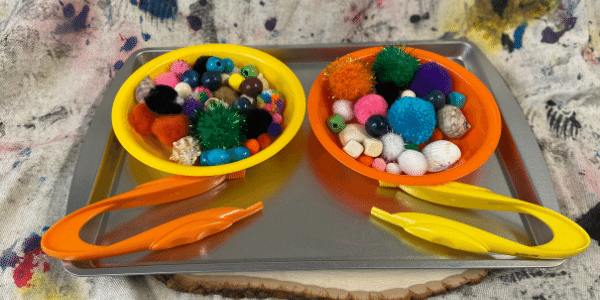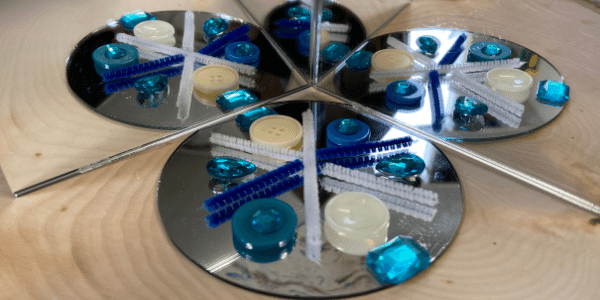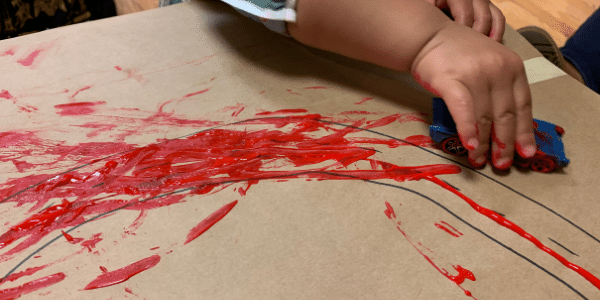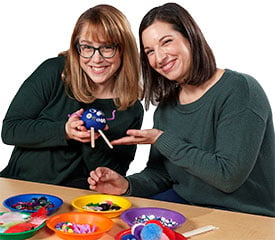You're Invited: To Create!

Setting Up an Invitation to Create
“Jose, look!” Sarah points to the table where her teachers have set up the dinosaurs they played with all last week. The children had spent hours engaged in imaginative play with the dinosaurs on the floor with blocks. “What’s this?!” Sarah asks her teacher. She points to a handwritten sign the teachers have positioned on the table next to the dinosaurs.
“Hi Sarah, you’re wondering what our sign says? It says ‘How will you use the dinosaurs with this dough and these loose parts?’ We’re wondering what you will choose to do with these materials. Remember how you and Jose played with the dinosaurs together with blocks last week?”
Sarah looks more closely at the table and notices that along with the dinosaurs, the teachers have laid out colorful balls of modeling dough, craft sticks organized neatly by color, small bowls of wiggle eyes, and chenille stems cut into small pieces and also organized by color. She is surprised by these new materials paired with the toys she had been using and is excited to start exploring. Jose, curious too, comes over and joins her. Together they create food for the dinos to eat, clothing for them to wear, and even dough animals for them to play with.
Our scenario above illustrates how a teacher (or other caregiver) might set up an ‘Invitation to Create.’ An invitation to create is a way of encouraging children to expand their thinking and play by presenting them with familiar materials in a novel and enticing way. Invitations to create are great ways to start your day at school or at home, whether when welcoming children into the classroom in the mornings, or at home when your child wakes up. They also work well for when children come home from school or childcare, or anytime when they seem stuck or bored with the toys and materials they have been using.
Spark Children's Imagination!
Look at some of the preschool process art ideas below that use everyday objects you might find in your classroom or at home and present them in ways that will spark children’s imagination and enhance their play.
![]() Looking to introduce a new concept, such as symmetry? Try setting mirrors upright on a table, with colorful materials, such as chenille stems (cut into smaller pieces), buttons, and beads, all arranged neatly and beautifully. Children can create designs on the table in front of them, with these designs reflected in the mirrors. Try adding photographs of symmetry found in nature, such as flowers, snowflakes, or butterfly wings for some inspiration.
Looking to introduce a new concept, such as symmetry? Try setting mirrors upright on a table, with colorful materials, such as chenille stems (cut into smaller pieces), buttons, and beads, all arranged neatly and beautifully. Children can create designs on the table in front of them, with these designs reflected in the mirrors. Try adding photographs of symmetry found in nature, such as flowers, snowflakes, or butterfly wings for some inspiration.

![]() Have children been using cars the same way every day? Bring cars over to your art area and put them out with paint and paper. Invite children to create paint roads and prints, made by dipping the cars into paint and driving them along paper. Add chenille stems and wooden craft sticks for more ways to create roads. What will children notice about the cars when they’re dipped in paint? How is this different than what they noticed when using the same cars in the block area? If you have blocks that can get painty, try adding those in too!
Have children been using cars the same way every day? Bring cars over to your art area and put them out with paint and paper. Invite children to create paint roads and prints, made by dipping the cars into paint and driving them along paper. Add chenille stems and wooden craft sticks for more ways to create roads. What will children notice about the cars when they’re dipped in paint? How is this different than what they noticed when using the same cars in the block area? If you have blocks that can get painty, try adding those in too!

![]() Do you have children who send most of their free play time prepping and serving meals in the kitchen area? Try adding a variety of loose parts, such as buttons, beads, craft fluffs, and pom poms, as well as plates. See what types of food children create to serve their guests! How will they engage with these materials differently than with pretend food that is for a specific purpose?
Do you have children who send most of their free play time prepping and serving meals in the kitchen area? Try adding a variety of loose parts, such as buttons, beads, craft fluffs, and pom poms, as well as plates. See what types of food children create to serve their guests! How will they engage with these materials differently than with pretend food that is for a specific purpose?
Invitations to create can be simple and quickly set up, and provide children with opportunities to use familiar materials in new ways. Often these invitations create meaningful learning experiences and help children expand and enrich their play. In our example of Jose and Sarah above, you can see how taking a few minutes to set up an invitation to create can lead to more dynamic play, and create an experience that is different from the previous play in which they had been engaged.
We hope you’ll give it a try and see what new ideas will be sparked!

With over 30 years of combined teaching experience between them, early childhood educators Nicole Werther and Rachel Miller know just how to keep your young children engaged—let them take the lead! Their small business, Backyartists, encourages creative thinking and discovery through the magic of process art and sensory play.
Rachel and Nicole are Becker's Creative Arts Content Advisors and have used their knowledge of process art to create resources, such as blog posts and activity ideas, to inspire teachers and parents when planning projects with the Artful Goods materials.
They also offer playgroups and classes in the Boston area. Check out Backyartists.com for the most up to date offerings.
